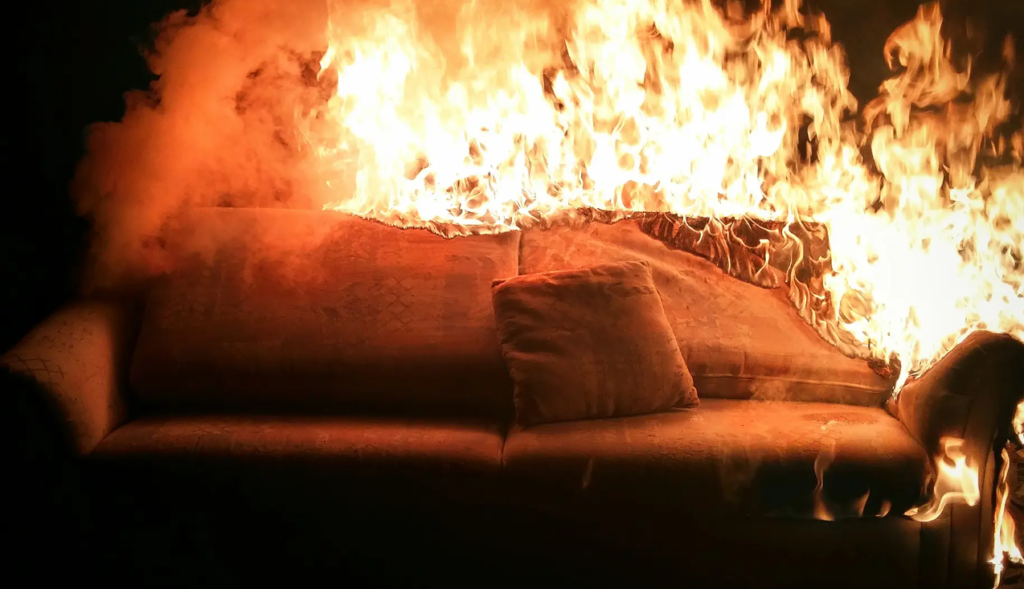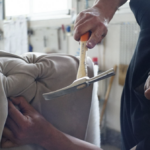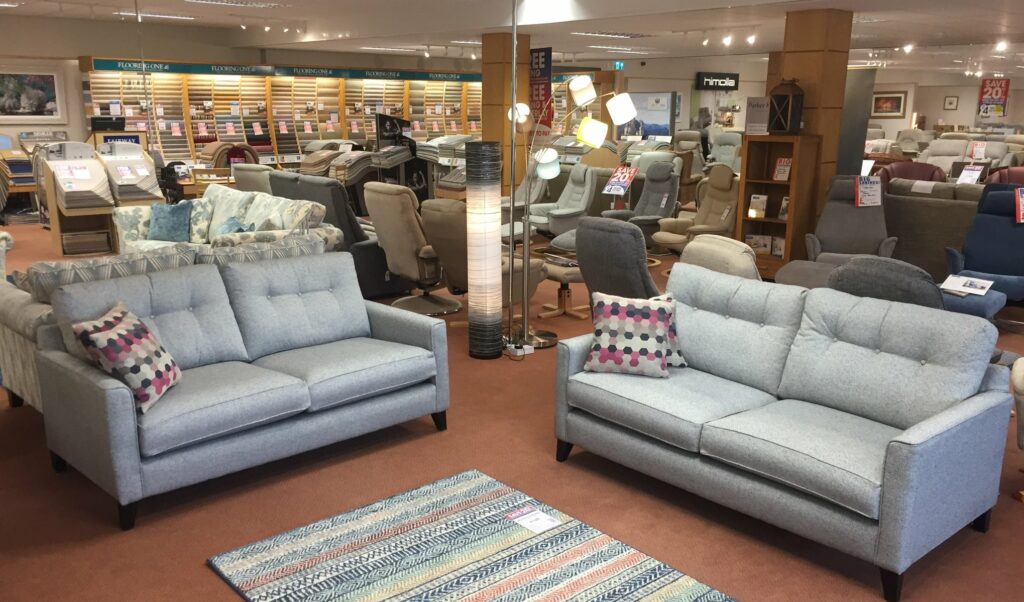A new independent research report on ‘Fire Risks of Upholstered Products’ has been published.
The report was commissioned by the Office for Product Safety and Standards from researchers at Oakdene Hollins, University of Birmingham, University of Central Lancashire and Whaley Research.
It summarises key evidence that can be used to inform policy proposals relating to the revision of the Furniture and Furnishings (Fire) (Safety) Regulations 1988. It presents information on fire statistics, fire-retardant strategies, the chemical flame retardants (CFRs) currently adopted for making furniture compliant with the regulations, and the potential contribution of furniture-derived CFRs to the high background levels of those compounds found in UK indoor environments.
It describes the methodology created to determine whether certain upholstered articles or products represent a significant fire risk. It applies this methodology to a systematic review of products, identifying holistic hazards and risks associated with the fire safety of furniture, and assessing the risk factors and weighting criteria for product types to be considered for inclusion or exclusion in the policy proposals.
A panel of furnishing industry experts were interviewed to contribute to the research and include, Angela Moran from Silentnight Beds Ltd, Gareth Mayhew from TCM Living Group, Dr Barend ter Haar from BES Healthcare and Julie Milne and Robert Anslow, both from the Baby Products Association.
The report details fire statistics for England, which show that most fires and most fire fatalities occur in dwellings. While most dwelling fires start in kitchens, most fire fatalities occur in fires that started in living/dining rooms and bedrooms.
Most people who die in fires are very old (25% of fatalities are 80 or over), or old (25% are 65-79). Most fire fatalities and most fire injuries result from inhalation of toxic smoke. England’s fire statistics report that upholstered furniture was the material or item first ignited in 1.5% of domestic fire incidents and 9% of fire fatalities; it was the main material responsible for fire development in 2% of fires and 15% of fire fatalities.
Similarly, beds/mattresses were the material or item first ignited in 1.5% of domestic fire incidents and 6% of fire fatalities; they were the main material responsible for fire development in 2% of fires and 11% of fire fatalities.
Taken collectively, the contribution of beds, mattresses and upholstered furniture in dwelling fire fatalities as the material or item first ignited was 15% and as the main fuel in fire development was 25%. The current FFFSRs require resistance to small ignition sources, such as a cigarette, match or 4 sheets of newspaper.
In contrast, contract furniture in pubs, hotels and offices requires a higher level of ignition resistance, equivalent to burning a child’s comic. This shows that compliance with the FFFSRs is aimed at suppressing ignition, but not retarding fire development.
With regards to testing, an extract from the report said: “In the UK, small manufacturers tend to rely on their suppliers for testing and certification, whilst larger manufacturers carry out due diligence testing on incoming batches of textiles, and of fillings, following the test methods defined in the regulations20.
“A recent report, commissioned by BEIS-OPSS and written by the Building Research Establishment (BRE) describes consultations with the furniture industry in relation to the FFFSRs, who felt they needed to be updated to reflect the change in environment seen in the modern home. It emphasised they need to consider alternative smouldering sources given that the only cigarettes available in the UK are reduced ignition propensity (RIP) which are considered insufficient to cause ignition of furniture items. Following the introduction of self-extinguishing, or RIP, cigarettes across Europe in November 2011, this concern was expressed21 for carrying out testing to EN 1021-122.
“However, when tested on upholstery it was found that RIP cigarettes burnt their full length, and so could be used for the testing of upholstered furniture composites. However, there may be an increased incidence of cigarettes not smouldering their full length. Therefore, it was agreed that moving to three ignition sources (cigarettes) rather than the current two would address this effectively.
“The furniture industry also suggested that the use of testing fabrics over non-combustion modified foam should be reviewed and standardised, given that the current foam was not widely available in the UK, there were no commercial applications for it, and it is unrepresentative of anything that could be used in UK furniture.”
Detailed within the report are expected outcomes from the research, which include:
“This research will inform policy proposals on if the products should be excluded from the new approach to furniture fire safety. It is proposed that there is an exclusion list for products who will not fall within the scope and that for manufacturers of these products there they are not required to meet this regulatory burden. Excluded products must comply with the General Product Safety Regulations (GPSR) and will still need to be safe. A balance must be struck between keeping high standards of fire safety and reducing exposure to chemical flame retardants. It is important that products within scope meet and continue to improve on the UK fire safety levels.
1. Strengthen evidence base on furniture fire safety
2. Collate cross-disciplinary evidence on fire safety and chemical exposure in a systematic review
3. Inform options for policy proposal for what products should, or should not, be in scope based on existing evidence
4. Resolve outstanding issues raised in existing research, which focus on the risks of chemical exposure to flame retardants versus the risk of products catching, and spreading, fires
5. If needed suggest areas for further research.”
The second part of the project focuses on developing a furniture fire safety risk matrix tool in order to assess peripheral furniture product types (cushions, pillows, baby products, garden furniture etc.), with a view to including or excluding whole furniture product types from the new furniture flammability regulations.
In parallel to this assessment of physical and fire protection parameters, a thorough review of the literature was undertaken in order to create robust and defensible concept networks identifying the driving forces in ignition, fire development and potential hazards. These overarching concept networks were then analysed, with the support of expert opinion, in order to develop risk matrices.
“To the best of our knowledge, this is the first time this type of approach has been applied to parameterising the significant fire and CFR exposure risks posed by furniture,” the report said. “It was valuable in that it allowed the empirical evidence base, i.e., scientific and other literature, to be analysed effectively and transparently. It uncovered the unevenness of concept coverage in the literature as well as providing the justification for our taking a more qualitative approach to ranking the furniture types than was originally intended.
“The fire safety risk matrix assesses the parameters likely to lead to development of a serious fire (one likely to cause death, serious injury or significant property damage) but crucially which includes user behaviour and mobility as well as flammability. Understandably, the factors driving fatality, injury and property damage were sufficiently similar that assessment of injury risk covered all three potential threats.
“The CFR exposure risk matrix covered the parameters governing the likelihood of exposure to CFRs, based on users and their behaviour, absorption routes, geometry etc. These two risk matrices have been combined into an overall furniture fire safety matrix. The matrix indicates that there are furniture types that present lower fire risk and higher potential for exposure, which may justify the reduction of use of CFRs in some of these types.”
To read the full report, click here.
Following the report, the Office for Product Safety and Standards and Department for Business and Trade has launched a consultation period, inviting views on the proposed new approach to the fire safety of domestic upholstered furniture and furnishings to replace the Furniture and Furnishings (Fire) (Safety) Regulations 1988. This consultation, which can be found here, closes at 11:59pm on 24 October 2023.















